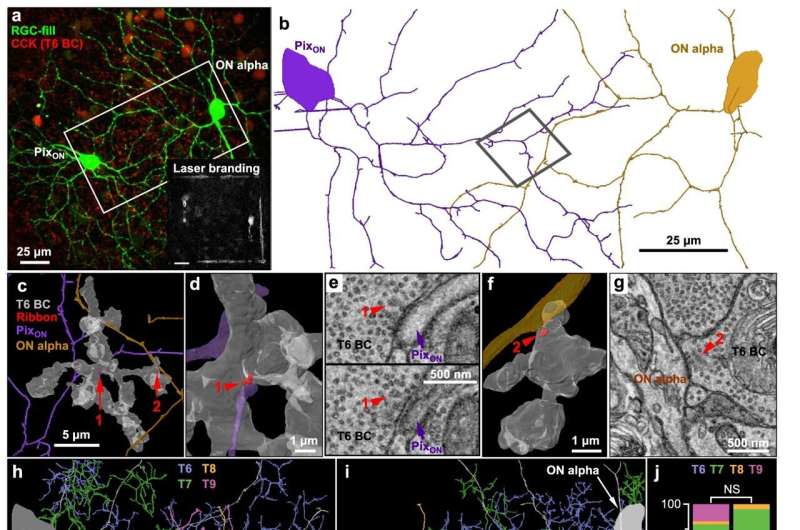This article has been reviewed according to Science X's editorial process and policies. Editors have highlighted the following attributes while ensuring the content's credibility:
fact-checked
peer-reviewed publication
trusted source
proofread
Shedding light on the synaptic complexities of vision

An individual retinal cell can output more than one unique signal, according to a Northwestern Medicine study published in Nature Communications, a finding that sheds new light on the complexities of how vision functions in mammals.
Bipolar cells in the retina are responsible for transmitting signals between photoreceptors in the eye and ganglion cells, a type of neuron which sends light-activated signals to the rest of the brain for processing.
Previously, it was believed that ganglion cells received different signals from different cell types in the retina, said Gregory Schwartz, Ph.D., the Derrick T. Vail Professor of Ophthalmology and senior author of the study.
In the current study, Schwartz and his collaborators employed single-cell electrophysiology and serial block-face scanning electron microscopy to track signals inside a mouse retina exposed to light. The team discovered that individual synapses in a bipolar cell in the retina can carry different signals to the neurons from the same light stimuli.
"We thought this would end up being relatively simple: That the ganglion cells get inputs from different cells. This is the classic circuit way to describe how cells have a different response, because their wiring diagram is different," Schwartz said. "But what was amazing was that that was not the case. There are differences inside very small neurons at the level of synapses, not at the level of which neurons they're actually connected to. That was surprising."

Because neurons can have hundreds or even thousands of synapses, the findings not only upend conventional theories about visual processing but also highlight how intricate and complex visual signaling can be.
"Even some of the very smallest neurons in the entire nervous system can respond differently to different synapses," Schwartz said.
The findings also have wider implications for understanding neuronal connections in the brain, said David Swygart, Ph.D., a former Ph.D. student in the Schwartz lab and first author of the study.
"We've known that each neuron could be a computational unit, but now we're thinking maybe each synapse should be considered a computational unit and there's a whole lot more synapses in the brain than there are neurons in the brain," said Swygart, who is now a faculty scientist at the Indiana University School of Medicine.
Schwartz and his collaborators will continue to study the synapses in the retina, he said, but more technological advancement is needed to better understand these tiny connections.
"We are right at the limit of modern recording technology here, because we're talking about very small things: two synapses that could be 10 microns apart, doing something different," Schwartz said. "You can't put electrodes on the two of them simultaneously, and even imaging, especially in the retina, has its own issues, obviously because you're using light to study light-sensitive circuits. Even the most advanced functional imaging techniques don't really get at the answer that we want to get at."
More information: David Swygart et al, A presynaptic source drives differing levels of surround suppression in two mouse retinal ganglion cell types, Nature Communications (2024). DOI: 10.1038/s41467-024-44851-w





















